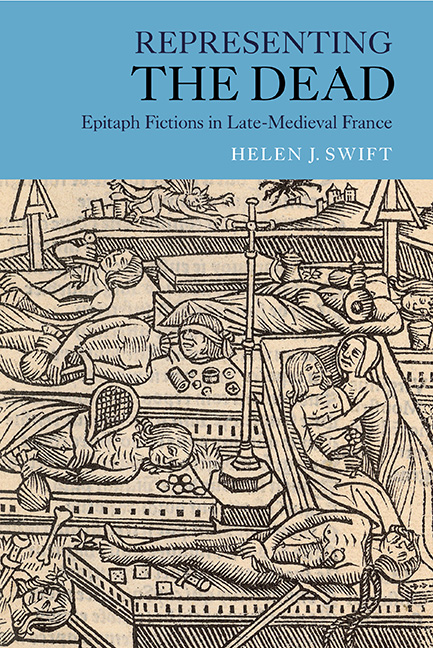Book contents
- Frontmatter
- Dedication
- Contents
- List of Illustrations
- Acknowledgements
- Note on Quotations
- List of Abbreviations
- Chronology of Epitaph Fictions
- Introduction: Representing the Dead
- 1 Framing Identity: ‘je suis’ and ‘cy gist’
- 2 Identity and/as Echo: the ‘Belle Dame’ querelle and Le Jardin de plaisance
- 3 Dying to be told: storytelling and exemplarity ‘selon le stile Jehan Bocace’
- 4 Placing the Dead: Cemeteries, Hospitals and Temples
- Afterword: Illustrating the dead
- Coda: Re-Member Me
- Appendix: Early Editions of the Jardin de plaisance et fleur de rethorique
- Bibliography
- Index
- Already Published
1 - Framing Identity: ‘je suis’ and ‘cy gist’
Published online by Cambridge University Press: 17 June 2021
- Frontmatter
- Dedication
- Contents
- List of Illustrations
- Acknowledgements
- Note on Quotations
- List of Abbreviations
- Chronology of Epitaph Fictions
- Introduction: Representing the Dead
- 1 Framing Identity: ‘je suis’ and ‘cy gist’
- 2 Identity and/as Echo: the ‘Belle Dame’ querelle and Le Jardin de plaisance
- 3 Dying to be told: storytelling and exemplarity ‘selon le stile Jehan Bocace’
- 4 Placing the Dead: Cemeteries, Hospitals and Temples
- Afterword: Illustrating the dead
- Coda: Re-Member Me
- Appendix: Early Editions of the Jardin de plaisance et fleur de rethorique
- Bibliography
- Index
- Already Published
Summary
As we have seen, a literary epitaph is essentially a statement of identity from a posthumous perspective. As we have also seen, however, the threshold between life and death is not secure, especially given the capacities of fictional writing to blur passage between the two, dwell on a liminal state in-between or experiment with multiple definitions of death. This means that ‘a posthumous perspective’ is not, strictly speaking, exclusive to someone who is depicted her-/himself already to have died or to a third party speaking about the deceased. The popular late-medieval genre of the literary testament is typically constituted, as Jacqueline Cerquiglini-Toulet has described, of three elements: confession, bequests and the prescription of an epitaph. It is with two such wills that I wish to begin an interrogation of the basic syntactic units of the epitaph that introduce its (usually) human subject. These syntagms are, in the case of first-person presentations, ‘[je] suis’, and, for third-person witnesses, ‘cy gist’: for example, the ‘epigramme’ of Sappho in the palace of illustrious ladies of Bouchet's Jugement poetic de l’honneur femenin (1538): ‘Je suys Sapho poetrice Lybique’ (v. 1936 [I am Sappho, the Aeolic poetess]), or the ‘epitaphe’ for Saint-Gelais's father in SH: ‘Cy gist Pierre, nommé de Saint Gelais’ ([Here lies Pierre, called of St Gelais]).
We should first reflect a little on the units themselves before examining their deployment. In the Introduction, I noted that estre and gesir are frequently the only main verbs to feature in an epitaph (certainly in the case of short inscriptions), with the remainder of the exposition of identity consisting of a series of descriptive components (nouns, adjectives, figurative expressions) arranged in asyndetonic apposition. I want here to explore the resonances of each syntagm, showing, especially in the case of ‘[je] suis’, how medieval writers’ manipulation of its component elements demonstrates a keen awareness of the stakes at play in defining identity epitaphically. In the twentieth century, Samuel Beckett's novel L’Innommable opens with an interrogative narrative voice of uncertain, possibly posthumous, status: ‘Où maintenant? Quand maintenant? Qui maintenant? Sans se le demander. Dire je’ [Where now? When now? Who now? Without questioning. Say I]. Such deictic questions concerning place, time and person of utterance are similarly key to medieval writers’ reflection on ‘[je] suis’ and ‘cy gist’, not least given that both phrases can be read as fundamentally paradoxical.
- Type
- Chapter
- Information
- Representing the DeadEpitaph Fictions in Late-Medieval France, pp. 37 - 90Publisher: Boydell & BrewerPrint publication year: 2016



